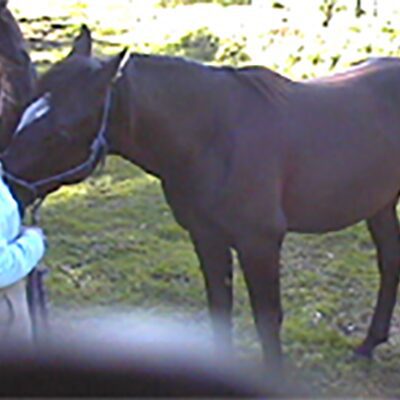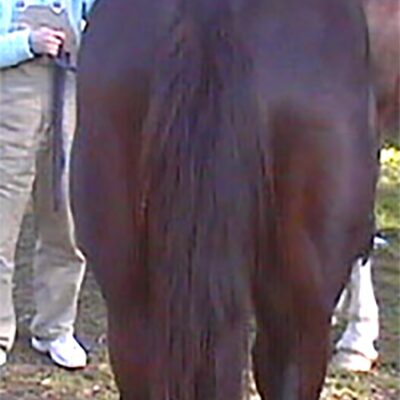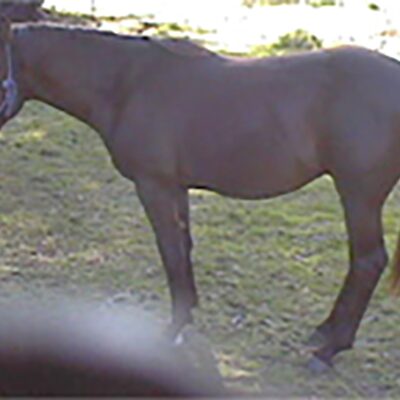Visit 1 – July 2005
This Case Study is a rising 2-year-old WB colt. Taylor broke his pelvis when he was 5 months old, trying to jump a gate. He failed and hooked his back legs in the gate and subsequently broke his pelvis. The break was through the off-side Illium and just above the Acetabulum on the near side. To my eyes, it appears to be a unilateral rotation/tilt. He has had the best of vet care and the last x-rays was taken on November, 04 the prognosis from the vet was he’ll make a good showjumper, as for higher level dressage where the break will affect the body mechanics. He is much higher on the right-hand side, his tail is carried to the left, yet his feet are worn evenly, he is cow hocked and appears to stand under himself. He can complete a turn on the haunches to the right but not the left and naturally his gait is affected. The tuber coxae, on the left-hand side, is much lower than the right.
For my first session with him, I simply worked on the sacrum, gluteal fascia, and lumbodorsal fascia. I tried working sandwich style on the quadriceps, but he wasn’t too keen on this. He wasn’t too bad with the high leg stretch – forward and it did telescope and soften.
After working on him for about an hour he was more free in his gait.
Visit 2
After the first visit, I emailed Ruth with a question on how best to deal with this situation. She instructed that I try several techniques held for 30 seconds. During this visit, I was able to use the sandwich technique on the quad and the reaction was amazing. The fascia was moving rapidly under my hands. At the end of this session, we noticed that he is standing square in the hind more often, rather than having his left leg forward.
Visit 3
During this visit, I worked the same as last week, concentrating on Longissimus, Spinalis, Gluteus accessories, gluteus medialis, gluteus profundus, Iliacus, Rectus femoris, gracilis and Adductors. Unlike last week, it took a while before I started to feel any movement of the facia. He appears to be more comfortable standing with the near side hind forward. Yet not as comfortable to stand square in the hind.
Visit 4
During this visit, I used cross-hand compression and direct pressure along the Longissimus and Gluteals on both sides with extra attention being paid to the left side. Interestingly, rather than fidget like he usually does, he stood still and leaned into my pressure. During this session at no time did I see the fascia moving and my hands did not glide.
I also worked in between his legs along the adductors and up as high as I could go which I hope reached the psoas using the sandwich technique. Today, he opened his legs to let my hand right in and up as high as it would go. Once again, I did not feel anything happening under my hands. All moves I held for approximately 3 minutes.
I finished off with hind leg stretches forward and back. The forward ones did telescope marginally and he didn’t appear to be uncomfortable doing this. The stretches backwards appeared to be a little harder and he wasn’t keen on me doing this, but was happier with his owner doing the stretch. I have asked her to perform each stretch once a day on each leg.
Visit 5
During today’s visit, nothing was different from last week. Though, he was very quiet standing there tied up (which is unusual) and had a few very big sighs. I did a fair bit of work along the longissimus on both sides today and up into the neck.
I emailed Ruth again about this horse and she explained I may not be feeling the fascia move as the movement may be happening beneath my hands and going deeper down into my body (like a corkscrew extending from the hands).
Visit 6
Pretty much the same as the previous visit. Still no facia movement to see so to speak. I’m still working on the same areas as in my previous visits and have the owner performing the stretches at least twice a week.
Visit 7
We had a breakthrough in this session. During this visit Taylor was very still, not swinging around and fidgeting like usual. The most significant thing was that he was leaning into me, the fascia started to move slightly (down towards the wither), he was sighing, his tummy was growling non-stop and he was passing wind regularly.
I am still working on Longissimus, Spinalis, Gluteus accessories, gluteus medialis, gluteus profundus, Iliacus, Rectus femoris, gracilis and Adductors. Though I did place more emphasis on the Longissimus, Gluteus Accessories, Multifidus thoracis et lumborum, and Obliquus internus abdominis. My hands had a bit of a glide starting today which is a change from my previous visits.
Visit 8
Visit 8 commenced like the previous visits. The facia appears that it is finally starting to move on the surface and it is visible what is happening. I am getting regular responses from Taylor in the form of leaning into me, sighing, licking his lips and passing wind.
November 2005
After discussing this case with Ruth, she requested to see Taylor when she was here in November. Ruth assessed Taylor and agreed with my observations. She said it was time to work deeper with him and proceeded to give him a rehab massage.
Following this massage with Ruth, I found that Taylor was softer through the back and was much freer in his movement.
April 2006
I have continued working weekly on Taylor with more pressure and am finding that he is moving a lot better. He has been started under saddle and am finding that the Longissimus, Spinalis, Gluteus accessories, gluteus medialis, gluteus profundus, Iliacus, Rectus femoris, gracilis and Adductors are usually quite tight by the time of my visit. Thankfully, this soon disperses following an MFR session.
Due to the way his pelvis has healed, Ruth is doubtful that we will ever succeed in aligning him, but I have found that his weekly massage helps to keep him supple and he is handling the new work of being under saddle with confidence and ease. He is also more comfortable standing reasonably square for longer periods.
Taylor is now in full work and his owner is very happy with his progress.



